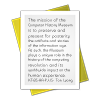Title
Gustafsson, Bertil SIAM oral historyCatalog Number
102746799Type
DocumentDescription
Gustafsson discusses his career in numerical analysis and applied mathematics in both Sweden and the United States with interviewer Phil Davis. Gustafsson's interest in mathematics began early. As a six year-old boy living in rural Sweden, he discovered his talent in mathematics thanks to a perceptive schoolteacher who lived with Gustafsson's family. While lucky enough to have several good teachers during his schooling, Gustafsson believes that being a good mathematician requires talent as well. Although undoubtedly talented, however, Gustafsson believes his success in numerical analysis is mostly attributable to hard work and a little luck.Gustafsson received his PhD from Uppsala, where there was a tradition of prominent mathematicians, including Arne Beurling and Lennart Carleson. When Heinz-Otto Kreiss arrived at Uppsala in the early 1960s, Gustafsson was in his second year, had already developed a strong preference for applied mathematics, and so quickly took to Kreiss, his work with numerical analysis, and the new field of computing. His dissertation was on difference methods for hyperbolic equations, and Gustafsson has continued to pursue topics in the field of differential equations for most of his subsequent career. Indeed, Gustafsson considers himself lucky to have hit on a hot topic area with his initial research, and much of his early work consisted of applying his theoretical developments to practical problems. These included weather prediction, both in Sweden and at the National Center for Atmospheric Research in Boulder, Colorado, and in a variety of problems in various fields during a one-year postdoc as an itinerant consultant searching for useful applications of differential equations in Swedish industry. Currently, Gustafsson is working with David Gottlieb on a variety of problems, which until recently included work in computer tomography.
Gustafsson, who often works with engineers, notes a certain tension between this group and mathematicians when the two work together, in which neither fully understands the challenges of the other's job. Part of the problem in working with industry is the question of proprietary versus open knowledge, and Gustafsson has encountered this issue often with his work at the Parallel and Scientific Computing Institute in Uppsala. Gustafsson believes that teaching while researching helps provide feedback for one's research, and so can be quite valuable. He suggests that incoming mathematics PhD. Students need a solid background in general mathematics, and notes that his program in Sweden requires students to have some experience in working with computers and to have taken a few courses in numerical analysis.
Date
2003-08-21Contributor
| Davis, Philip, Interviewer |
| Gustafsson, Bertil, Interviewee |
Publisher
SIAM and U.S. Department of EnergyPlace of Publication
Providence, Rhode Island, United StatesExtent
15 p.Format
PDFCopyright Holder
Computer History MuseumCategory
TranscriptionSubject
Differential equations; Hyperbolic partial differential equations; Partial differential equation (PDE); Computed tomography (CT); Numerical analysisCollection Title
Society for Industrial and Applied Mathematics (SIAM) oral history collectionCredit
Gift of SIAM and the US Department of EnergyLot Number
X6673.2013Related Records
| 102746778 | Society for Industrial and Applied Mathematics (SIAM) oral histories collection |


